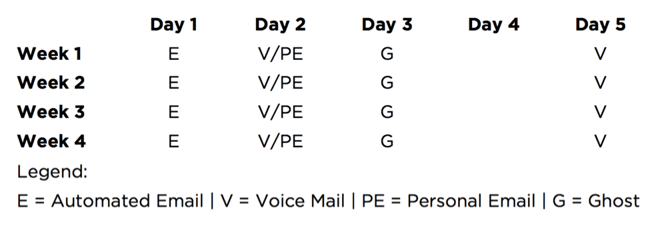 I’m a huge fan of inbound marketing. It has been instrumental in making Imagine Business Development what it is. It has allowed me to compete on a larger playing field, to grow a company that was (and is) self-funded and to do so in a way that is sustainable and scalable.
I’m a huge fan of inbound marketing. It has been instrumental in making Imagine Business Development what it is. It has allowed me to compete on a larger playing field, to grow a company that was (and is) self-funded and to do so in a way that is sustainable and scalable.
But, it’s not enough. I remember when we posted our first white paper and when we hosted our first webinar. I got the notification that someone had downloaded and registered. I was excited because it meant that someone actually did want to see our material, and it was just a matter of time before they reached out to ask how we could help them.
So I waited for my phone to ring. And I waited. And waited. Needless to say that phone call didn’t come. I quickly learned that people don’t download content or attend webinars because they want to buy something; they do so because they want to learn something.
While a small percentage of these people will reach out to the seller on their own volition, it’s not the norm. Certainly some people sell the concept of inbound marketing as:
Step 1: Create Content
Step 2: People Download Content
Step 3: Salesperson connects with prospect
Step 4: Prospect buys
The reality, of course, is quite different. As your inbound marketing efforts ramp up and you start creating a steady stream of leads, you’ll typically find:
- The person downloading the content is lower in the organization and isn’t “the decision maker.”
- The prospect isn’t currently considering (or even thinking about) buying the product/service you sell.
- The prospect has the problem you solve, but they think they can solve it on their own (that may have even been what prompted them to download your content to begin with).
- The prospect has competing priorities and isn’t currently allocating any (or enough) resources towards the problem you solve.
- The prospect is unclear about your value proposition, what you do or why it matters.
This is where the systems, skills and disciplines mastered with outbound sales efforts come in handy. Any organization that has succeeded with outbound is familiar with these challenges and knows how to deal with them.
Recently, we were talking with a company that was in the midst of launching an inbound marketing program. The agency they were working with recommended they talk with us about building a sales development process to align with and accelerate their results.
After talking with them, they admitted that they had not realized everything that was needed to turn inbound leads into sales qualified leads, and ultimately revenue.
There are several facets you need to have in place to ensure your inbound program predictably transforms leads into revenue.
You must have a disciplined lead classification process
The single most important component of a successful outbound campaign is the list that is developed for the campaign. Significant effort (and expense) is expended to ensure that the quality and accuracy of the list is high and that the companies on that list likely fit your ideal client profile.
At the core, inbound leads are a means for list creation. Instead of you having to work hard to identify potential companies, they find you. That said, every lead is not created equal. You must have a process for classifying leads as they come in and those classifications must plug into defined actions and cadences for follow up and nurturing.
The advantage of outbound lists is that you have far more control over who gets on the list. The disadvantage is that no one on an outbound list has done anything to indicate they’re open to any type of dialogue or engagement. For inbound, it’s just the opposite.
Oh yeah, remember when you’re qualifying a lead, you’re always qualifying the company not the contact. So if the wrong person from the right type of company downloads something, you should treat them as a qualified lead.
You must establish a follow up and nurture cadence
Seventy-nine percent of marketing leads never convert into sales. A lack of lead nurturing is the common cause. (Source: MarketingSherpa) But simply adding names to pre-defined drip programs is not enough.
The lead classification should determine the cadence you follow. For most qualified leads that cadence should include:
- Marketing driven nurture emails, designed to fit the prospect’s context
- Outreach from a sales development rep (SDR) or salesperson
- Personal emails from the rep making the outreach
The cadence should be clearly defined articulating the action that should occur and when it should happen. All emails and outreach should be tracked and the analytics should be monitored to identify which emails, scripts and timing works best.
Sample Cadence:

There are several reasons that we recommend having a dedicated capability to executing this cadence. A key reason is that you must stick to the cadence for it to work. This is not something you want to leave to chance. When you mix this responsibility with other sales functions, the follow up activities get pushed to the side and you waste your leads.
You must pick up the phone and call
That’s right, you’ve got to be willing to pick up the phone and call the people who downloaded something. I’m surprised how often one of our SDRs or I follow up on an inbound lead and the prospect responds, “I’m so glad you called. I’d really like to talk to you about…” I love following up on these leads because I’m often greeted as a friend rather than an intruder.
Now I have to admit that I often ask myself, if they’re so happy that I called and they’re ready to talk to me about something, why didn’t they pick up the phone or send me an email? Then I realize that the answer to that question isn’t particularly meaningful. The reality is that’s how they act and it’s up to me to adjust.
An important note here is that you can’t handle these leads in the traditional way that people cold called in the past (the truth is that wasn’t a particularly good idea back then either). If you make the call with the intent of selling your stuff, you’ll probably face a lot of resistance and fail. Instead you must approach them from a position of assistance and look for ways you can help them.
This often means that you must have additional content and tools that you can share with them that reiterate the value you provide. You must also have a clear process for expanding your connections within these prospects.
You must be willing to overcome objections
Let’s pretend you’ve walked into Nordstrom’s and you’ve walked to the area that has clothes that you’re interested in. A salesperson comes over and asks, “How can I help you today?” What’s your typical, immediate response?
Most likely you say something like, “Just looking, thanks.” Why do you say that, when you know you’re there to buy something? Typically it’s because you feel threatened and don’t want to be sold to.
The same is true when you follow up on inbound leads. There may have been a time when the majority of people who downloaded something greeted a call with a great degree of receptivity, but today with so many people implementing these practices poorly; prospects have their guard up.
When I make follow up calls I often hear responses like “just looking,” “this is something we’re doing on our own,” or even “we’ve already got someone providing these services for us.” I’m not surprised by any of these statements, actually I expect them.
I realize that they merely have their guard up and don’t want to be sold to. My approach is built to get behind those objections and get a conversation started. That’s why I start my conversation with questions about them and directly connected to what their digital body language is telling me. I’m prepared with additional insights to complement the content they’ve reviewed and resonating questions that get them to think. I’ve got an advantage when I do this, because I learned how to do it when I was doing purely outbound.
So, why do inbound at all?
Some of you may be reading this and thinking, “If I have to master the skills of outbound, why even do inbound marketing at all?”
The answer is that if you’re not doing it, then your outbound efforts will fail. Without blogs, white papers, lead nurturing, webinars and other content, you are a glorified smiler-and-dialer. You bring no value and you have no leverage. The complexity of today’s sales world will simply overwhelm your efforts (and you’ll waste a lot of money in the process).
Of course, if you do inbound without mastering outbound, you’ll create a lot of value, positive feelings about your company and thought leadership. But you’ll be left waiting and wondering about when the revenue will start showing up.
That’s why at Imagine Business Development, we say, “It’s not about inbound, it’s not about outbound; it’s all about allbound!”

 Doug Davidoff
Doug Davidoff